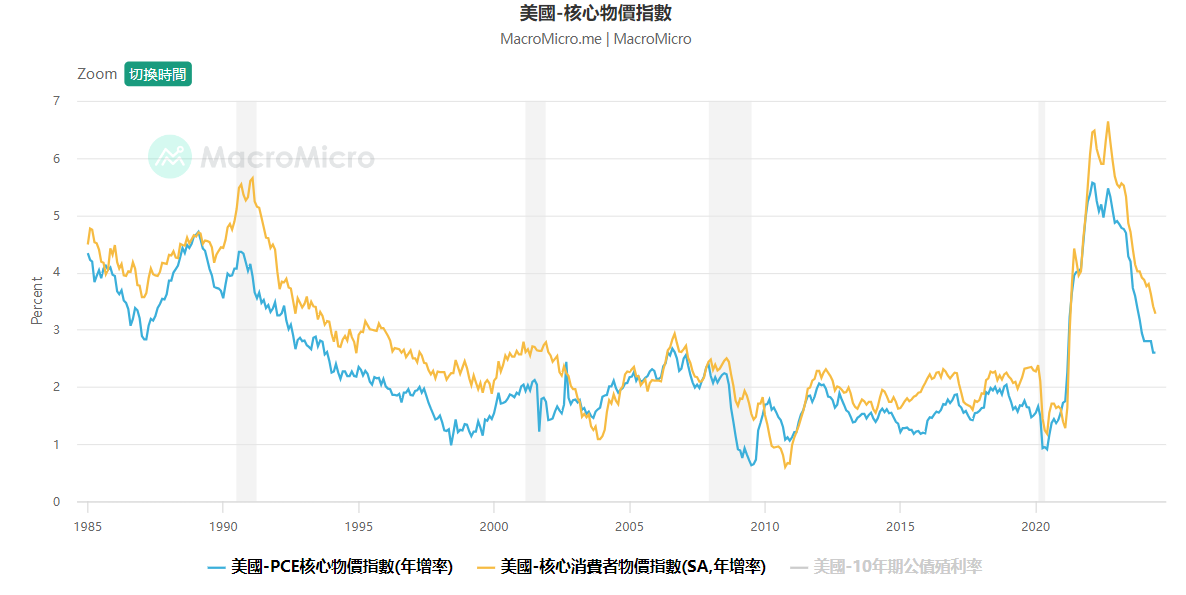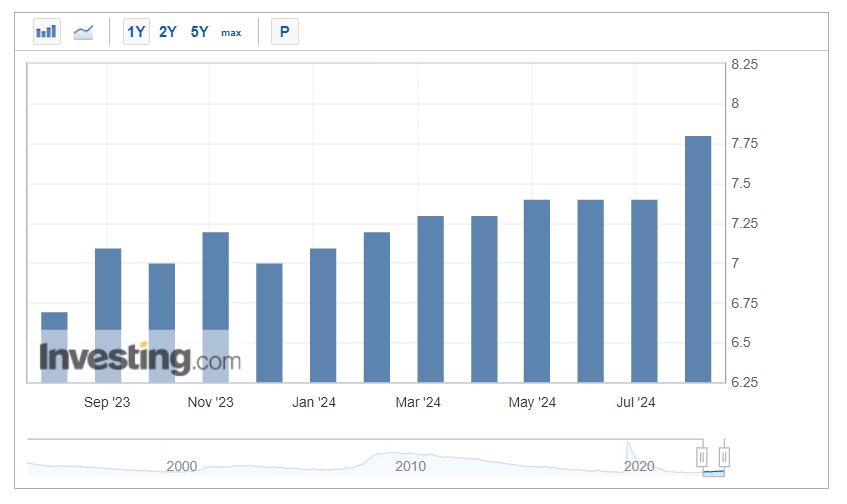On Monday (5) this week, due to the rising unemployment rate in the United States, triggering the "Sam Rule" that indicates an economic recession, the U.S. stock market plummeted, and the disaster also affected Asian stock markets such as Japan, South Korea, and Taiwan.
Regarding the violent fluctuations in the capital market, business leaders including Musk and Wall Street analysts have said that the US Federal Reserve (Fed) should make an interest rate cut decision early to avoid a hard landing of the US economy.
However, it is worth noting that the Fed seems unmoved by the market's voice, because in the final interest rate decision, they will not use the changes in the capital market as the criterion, but will use the two major economic indicators of inflation and unemployment as the criterion. in accordance with.
Inflation indicator
As the Federal Reserve has emphasized many times, the primary indicator is inflation. The Federal Reserve will comprehensively consider whether it is necessary to adjust interest rates based on the changes, causes and expectations of inflation, combined with economic growth and labor market conditions, to achieve its dual mission of stabilizing prices and promoting full employment. The details are as follows:
1. Inflation target
The Federal Reserve has set a long-term inflation target of 2% annual growth. The target is measured based on the rate of change in the personal consumption expenditures (PCE) price index. When the inflation rate is above this target, the Fed may consider raising interest rates to cool economic activity and thereby reduce inflationary pressure; conversely, when the inflation rate is below the target, the Fed may consider cutting interest rates to promote Economic growth has pushed prices back to target levels.
2. Causes of inflation
The Federal Reserve will analyze whether the rise in inflation is due to demand-pull or cost-push. If it is inflation caused by overheating demand, the Fed may raise interest rates to curb excessive consumption and investment demand; and if it is cost-push inflation caused by supply-side factors such as supply chain disruptions and rising raw material prices, The Fed's decision-making may be more cautious, because simply raising interest rates may not effectively solve these problems.
3. Expected inflation
Expected inflation refers to consumers’ and businesses’ expectations of future changes in price levels. The Fed takes expected inflation very seriously because it affects actual price-setting behavior. If inflation is expected to rise, companies may increase prices ahead of schedule and workers may demand higher wages, further pushing up actual inflation. Therefore, the Federal Reserve may raise interest rates to reduce expected inflation and prevent an inflationary spiral.
4. Core inflation rate vs. headline inflation rate
The Fed typically focuses more on core inflation, which excludes volatile food and energy prices. The core inflation rate better reflects underlying inflationary trends in the economy. If core inflation continues to rise, indicating that there may be widespread price pressures in the economy, the Fed may consider raising interest rates; conversely, if core inflation is lower or declining, the Fed may maintain or lower interest rates. .

5. The trade-off between inflation and employment
When the Fed considers inflation, it also considers the state of the labor market. This trade-off is known as the "Phillips Curve," which describes the inverse relationship between inflation and unemployment. When the job market is overheated and unemployment is extremely low, rising wages may drive up inflation, and the Fed may raise interest rates. However, if unemployment is high and inflation is subdued, the Fed may choose to cut interest rates to stimulate the economy. , thereby increasing employment.
6. Balance between economic growth and inflation
The Fed wants to promote economic growth while avoiding excessive inflation. Therefore, the Federal Reserve will decide whether to adjust interest rates to curb or promote inflation based on the strength of economic growth. If economic growth is strong and accompanied by high inflation, the Federal Reserve may raise interest rates to prevent the economy from overheating; while if the economy is weak and inflation is low, the Federal Reserve may lower interest rates to stimulate the economy and increase prices.
unemployment rate indicator
Another economic indicator that affects the Fed's decision-making is the unemployment rate. When the Federal Reserve considers the unemployment rate, it not only looks at the level of the number, but also conducts an in-depth analysis of the underlying economic structure, wage dynamics, labor market participation and other factors, and combines inflation expectations and economic growth prospects to decide whether it is necessary Adjust interest rate policy. The details are as follows:
1. The goal of full employment
One of the Fed's dual missions is to promote full employment. This does not mean cutting the unemployment rate to zero, but maintaining it within a natural rate of unemployment, which is the lowest rate the economy can maintain without triggering excessive inflation.
If the unemployment rate falls below this range, the labor market may be overheating and the Fed may raise interest rates to prevent rising inflation. If the unemployment rate rises above this range, the Fed may lower interest rates to stimulate economic growth and employment.
2. The relationship between unemployment rate and economic growth
When unemployment rises, it usually means a slowdown in economic growth or a recession. The Federal Reserve will pay attention to this phenomenon and consider cutting interest rates to stimulate economic activity. Cutting interest rates can lower borrowing costs and boost consumer spending and business investment, which in turn can boost economic growth and reduce unemployment.
3. Structural issues in the labor market
The Federal Reserve will analyze the reasons behind the unemployment rate and determine whether it is due to cyclical factors (such as economic recession) or structural problems (such as skills mismatch or industrial transformation). If the rise in unemployment is caused by structural problems, simple interest rate cuts may not be able to effectively solve the problem, and the Fed may take broader economic policy measures to promote employment.
4. Wage growth and inflationary pressure
The Fed will keep a close eye on wage growth because it is closely tied to the unemployment rate. When unemployment is very low, businesses may raise wages to attract and retain labor, which may push inflation higher. If wages grow too fast, the Fed may raise interest rates to curb inflationary pressures; conversely, if wages grow slowly, the Fed may keep interest rates low to promote economic growth.
5. U6 Unemployment Rate and Labor Participation Rate
In addition to the traditional unemployment rate (U3), the Fed will also look at the broader U6 unemployment rate, which includes those who have given up looking for work or can only find part-time work.

In addition, the Fed also looks at the labor force participation rate, which is the proportion of the population that is employed or looking for work. If the labor force participation rate declines, it may indicate underlying problems in the labor market, and even if the unemployment rate appears to be low, the Fed may consider cutting interest rates to encourage more people to participate in the labor market.
6. The Philip Curve between unemployment rate and inflation
The Philip Curve describes the inverse relationship between the unemployment rate and the inflation rate. When unemployment falls to very low levels, inflationary pressures tend to rise, and the Fed may raise interest rates to prevent inflation from rising too quickly. However, this relationship is not always stable in a modern economy, so the Fed will respond flexibly depending on the current economic situation.
7. Anticipate future economic trends
The Fed also considers future economic prospects, including expectations for possible changes in the unemployment rate. If economic growth is expected to accelerate and the unemployment rate will fall further in the future, the Fed may raise interest rates early to prevent the economy from overheating; conversely, if the unemployment rate is expected to rise, the Fed may cut interest rates early to prevent an economic recession.





